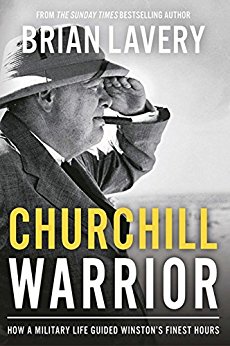
Finest Hour 178
Books, Arts, & Curiosities – Misguided History

April 2, 2018
Finest Hour 178, Fall 2018
Page 46
Review by Raymond Callahan
Brian Lavery, Churchill Warrior: How a Military Life Guided Winston’s Finest Hours, Casemate, 2017, 448 pages, $32.95. ISBN 978–1910860229
Raymond Callahan is Emeritus Professor of History at the University of Delaware.
Central to Winston Churchill’s story is the moment in May 1940 when, amidst disaster, he became Prime Minister and Minister of Defence. “I thought I knew a great deal about it all,” he later wrote about that moment, and, indeed, he had a very impressive resume for the task he was about to undertake. He had, in addition to a brief, adventurous subaltern career at the end of Victoria’s reign and a short spell as a battalion commander on the Western Front in 1917, been the ministerial head of each of the fighting services, Minister of Munitions, and, as Chancellor of the Exchequer, had made decisions that helped shape the armed forces that, as Minister of Defence, he would now direct. Furthermore, no one in British public life had a longer perspective on the strategic problems of a global empire whose commitments had not been matched by comparable resources since 1918 (if not 1900).

2024 International Churchill Conference
How the knowledge that Churchill had accumulated shaped his perceptions and actions during the Second World War is a subject very much worth examining. Brian Lavery’s subtitle “How a Military Life Guided Winston’s Finest Hour” seems to promise just such an exploration. His book, however, does not really deliver one. It has certain strengths, perhaps the most important being that it is clearly and energetically written—Lavery is an experienced writer with a number of other books to his credit. He is an emeritus curator at Britain’s National Maritime Museum, and his previously published work has been in naval and maritime history.
The strongest parts of this book, not surprisingly, deal with the Royal Navy. But the greatest weakness of the book is not its understandable maritime bias but the research base on which it rests and the link between that and the issue he is trying to explore: what Churchill brought to 10 Downing Street from his past involvement with Britain’s fighting services and how that accumulated knowledge shaped what he then did. Lavery leans very heavily on the documentation provided by the companion volumes to the official biography. He has also consulted archival collections—chiefly Cabinet and Admiralty papers. But to do what he sets out to do, it would have been necessary to master the now vast literature written not from the prime minister’s perspective
but from that of the services with which he dealt.
The conversations between the Minister of Defence and the Admiralty, War Office, and Air Ministry were two-way. One of the great problems with the official biography companion volumes is that we usually hear only one side of those conversations. (The recent volumes, produced by Larry Arnn and his team, have begun to rectify that somewhat.) Moreover, the companion volumes reflect Churchill’s concerns at any given moment. If the prime minister was not focusing on an issue, neither do the documents—and neither does Lavery. Britain’s war against Japan is therefore barely mentioned. To tease out what Churchill had learned before 1940 and carried forward with him into his war leadership years, and how exactly it played out in his relations with the services, requires exploration of a much wider range of materials than those found in the companion volumes, rich as that source is.
Mastery of all relevant archives—for which a lifetime would barely be sufficient—is not necessary, but a thorough trawl through the now-abundant monographic literature is. Here Lavery’s bibliography indicates considerable gaps. The work of Stephen Roskill and Arthur Marder on the Royal Navy, David French and Brian Harrison Place on the army, and Richard Overy on the strategic bombing offensive—just to mention a few—do not appear. Lavery’s book, readable as it is, does not fulfill the promise of its subtitle. It can, however, certainly be read by someone starting an expedition into the subject (although no professional historian at this date should still be repeating as fact the hoary legend that Singapore’s guns could only fire to seaward!), but it will not be of very great help to serious students of Churchill’s finest years.
Subscribe
WANT MORE?
Get the Churchill Bulletin delivered to your inbox once a month.


